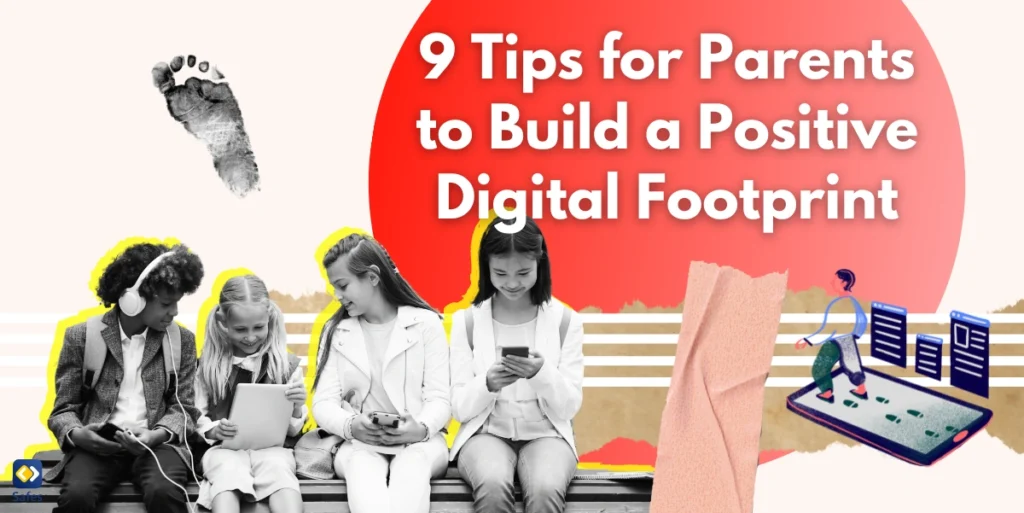In today’s digital age, a child’s online presence can open doors—or close them. Every post, comment, or shared photo contributes to their digital footprint, which can significantly impact future opportunities. Understanding the benefits of a positive digital footprint is essential for helping your child navigate the online world wisely and effectively.
Download and Start Your Free Trial of the Safes Parental Control App
With colleges and employers increasingly turning to the internet to vet applicants, a strong and positive online presence has never been more important. Recent statistics from BitDefender reveal that approximately one-third of colleges review applicants’ digital footprints, while nearly three-quarters of recruiters are mandated by their companies to conduct online research on candidates. Digital footprints can showcase a child’s achievements and character, influencing decisions in education and employment sectors in ways that can have lasting impacts.
As parents, you hold the key to guiding your children toward responsible online behaviors. By actively participating in their digital lives, you can help them build a footprint that reflects positively on them now and in the future, setting them up for success.
What Is a Digital Footprint?
A digital footprint encompasses all the traces your child leaves online, both intentionally and unintentionally. This includes the photos they post, the comments they make, and even the websites they visit. Understanding the digital footprint for children is crucial in today’s connected world, where every action can contribute to a lasting online presence.
There are active footprints, like social media posts, and passive ones, such as data collected by websites. Both contribute to the overall picture of a person’s online identity. Recognizing the positive aspects of a digital footprint can help your child make mindful choices online that will reflect well on their character.
Every click, share, or like adds to their digital story. Being aware of this helps them understand the importance of cultivating a footprint that reflects their best selves and can positively influence their future opportunities.
1. Educate Your Child About Online Permanence
Once something is posted online, it can be challenging to remove it entirely. Photos and comments can be shared, saved, or screenshot by others, making them effectively permanent. Sharing positive digital footprint examples can illustrate the lasting impact of online actions and help children understand the gravity of their online behavior.
Real-life stories abound of individuals whose digital footprints have affected their education or career prospects, both positively and negatively. Discussing these cases can make the concept more tangible for your child, showing them how online actions can have long-term consequences.
Keeping the lines of communication open encourages your child to share their online experiences with you. This dialogue fosters responsible online sharing and helps them make better decisions that contribute to a positive and secure digital footprint.

2. Set Clear Guidelines for Online Behavior
Establishing family rules for internet use sets clear expectations. Discuss acceptable times for online activities and appropriate platforms for their age. Together, you can create a positive digital footprint by setting boundaries that ensure your child engages in healthy and productive online behavior.
Define what content is acceptable to post and share. Topics like personal information, photos, and opinions should be approached thoughtfully and with caution. Setting these guidelines helps your child navigate online spaces safely while reinforcing the importance of maintaining privacy.
Consider formalizing these rules with a family agreement. This can serve as a tangible reminder of the standards you’ve set and the importance of adhering to them. Such agreements also help children understand their responsibilities and the consequences of not following the established guidelines.
3. Encourage Positive Content Creation
Motivate your child to share their achievements and talents online. This not only boosts their confidence but also contributes to a positive digital presence that can benefit them in the long run. Teaching social media literacy empowers them to use platforms wisely and effectively.
Suggest engaging activities like blogging about their hobbies or creating educational videos. These endeavors show them how to create a positive digital footprint that showcases their interests and skills in a constructive way. It also gives them a creative outlet to express themselves online.
Highlight how such positive content can enhance their online reputation. It can make a favorable impression on future educators or employers who might review their digital footprint, giving them an edge when opportunities arise that require an online review of their profile.
4. Monitor Privacy Settings Together
Privacy settings are essential tools for controlling online exposure. Teach your child how to adjust settings on social platforms to manage who can see their content. This hands-on approach reinforces the importance of digital privacy and ensures they are equipped to protect their information.
Regularly reviewing these settings ensures they remain appropriate as platforms update features. It’s an opportunity to discuss the balance between sharing and maintaining personal privacy, and to adjust settings as needed to reflect your child’s changing online behavior.
Understanding privacy tools helps your child make informed decisions about their online interactions. This knowledge contributes to a safer and more positive online experience, where your child can confidently manage their digital presence while protecting their personal information.
5. Be a Positive Online Role Model
Children often mimic their parents’ behaviors, both offline and online. Demonstrate responsible digital habits through your own actions. By modeling good practices, you set a standard for them to follow and provide a real-world example of healthy digital behavior.
Share stories of positive online interactions you’ve had. Whether it’s reconnecting with an old friend or learning something new, these experiences highlight the benefits of the digital world and show how it can be used to enrich lives in a meaningful way.
When encountering negativity online, show them how to handle it gracefully. Your response can teach them valuable lessons about resilience and respectful communication, skills that are essential both in the digital realm and in everyday life.
6. Discuss the Consequences of Negative Behavior
It’s important to talk about how negative online actions can have serious repercussions. The impact of a digital footprint extends beyond the screen, affecting real-life relationships, job prospects, and social opportunities. Understanding this can help children be more mindful of their actions.
Provide examples of cyberbullying and its effects on both the victim and the perpetrator. These discussions can foster empathy and discourage harmful behavior, helping your child understand the profound impact their words and actions can have on others.
Stress the importance of treating others with respect in all forms of communication. Emphasizing kindness helps your child build a positive reputation online and offline, making their digital footprint something they can be proud of in the future.
7. Teach Critical Thinking Before Posting
Introduce the THINK acronym: Is it True, Helpful, Inspiring, Necessary, Kind? This tool encourages your child to evaluate their content before sharing, helping them think carefully about the impact their words may have before they hit the post button, ensuring that they contribute positively to online conversations.
Encourage them to pause and reflect on their posts. This moment of consideration can prevent impulsive sharing that might be regretted later, promoting more thoughtful and meaningful interactions online, and fostering an environment where they feel confident and responsible about their online actions.
Role-playing different scenarios can help them practice thoughtful decision-making. By anticipating potential outcomes, they become more mindful digital citizens, capable of making decisions that contribute positively to their digital footprint, ultimately reinforcing their understanding of the importance of responsible online behavior.

8. Stay Updated on Digital Trends
The digital landscape evolves rapidly. Keeping informed about new apps and platforms your child uses allows you to guide them effectively and helps you stay aware of potential risks or benefits associated with these technologies, ensuring that your child has a safe and constructive experience online.
Engage in conversations about what they enjoy online. Understanding their interests helps you connect with them and provides opportunities to discuss online safety and appropriate behavior in a way that feels relevant and engaging to them, building trust and encouraging openness about their online experiences.
By staying current, you can anticipate challenges they might face and offer timely advice. This not only helps protect them but also strengthens the trust between you, showing that you are involved in their digital world in a supportive way, making them feel comfortable turning to you when issues arise.
9. Use Parental Controls Wisely
Parental control apps and tools can help monitor and limit online activity. Implementing these measures appropriately ensures your child’s safety without infringing on trust, allowing them to explore the digital world while staying safe.
Discuss the use of these controls openly. Transparency helps maintain a positive relationship and encourages responsible behavior. Your child will be more receptive to boundaries if they understand that these measures are in place to protect them.
As your child demonstrates increased responsibility, consider adjusting the controls. This shows that you respect their growing maturity and trust them to handle more freedom responsibly, which can ultimately strengthen your relationship.
Safes: Building a Positive Footprint
Parental control apps are valuable allies in building a positive digital footprint. Our product, Safes, offers tools to help you guide your child’s online journey effectively and ensure their digital interactions are safe and productive.
Safes provides features that allow you to monitor activity, set screen time limits, and block inappropriate content. By trying our free trial, you can experience how it supports your efforts in promoting safe and responsible internet use. Downloads are available on both iOS and Android platforms, making it accessible to everyone.
Conclusion: A Brighter Future
Cultivating a positive digital footprint from a young age sets the foundation for future success. This post provides practical steps on how to build a positive digital footprint, emphasizing proactive parenting and open communication as key components of digital safety, helping to ensure your child grows into a responsible and conscientious digital citizen.
Encouraging ongoing dialogue about digital citizenship keeps the conversation relevant as technology evolves. Education is an ongoing process, and staying engaged makes a significant difference in how your child learns to navigate their digital life, fostering a sense of responsibility and awareness about their digital actions and choices.
By taking action now, you’re investing in your child’s future. The long-term benefits of a positive online presence are substantial, opening doors to opportunities they might not otherwise have and helping them succeed in an increasingly digital world, where their digital reputation can be a crucial factor in achieving their goals.
Your Child’s Online Safety Starts Here
Every parent today needs a solution to manage screen time and keep their child safe online.
Without the right tools, digital risks and excessive screen time can impact children's well-being. Safes helps parents set healthy boundaries, monitor activity, and protect kids from online dangers—all with an easy-to-use app.
Take control of your child’s digital world. Learn more about Safes or download the app to start your free trial today!




